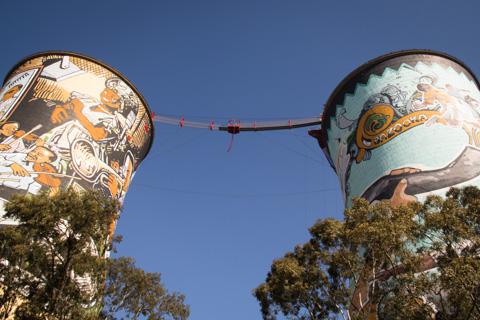How much does it cost to travel to Soweto?
You should plan to spend around $63 (R1,151) per day on your vacation in Soweto. This is the average daily price based on the expenses of other visitors.
Past travelers have spent, on average for one day:
- $21 (R379) on meals
- $12 (R219) on local transportation
- $65 (R1,177) on hotels
A one week trip to Soweto for two people costs, on average, $887 (R16,121). This includes accommodation, food, local transportation, and sightseeing.
All of these average travel prices have been collected from other travelers to help you plan your own travel budget.
Independent Travel
Traveling Independently to Soweto has many benefits including affordabilty, freedom, flexibility, and the opportunity to control your own experiences.
All of the travel costs below are based on the experiences of other independent travelers.
Is Soweto expensive to visit?
Soweto is a reasonably affordable place to visit. Located in South Africa, which is a reasonably affordable country, visitors will appreciate the relatively low cost of this destination. It falls in the average range in the country for its prices. If you're traveling on a budget, then this is a good destination with affordable accommodation, food, and transportation.
Within Africa, Soweto is a moderately priced destination compared to other places. The overall cost of travel here is fair for the region and comparable to Nairobi or Mombasa.
For more details, and to find out if it's within your travel budget, see Is Soweto Expensive?
How much money do I need for a trip to Soweto?
The average Soweto trip cost is broken down by category here for independent travelers. All of these Soweto travel prices are calculated from the budgets of real travelers.
|
Category
|
Cost
|
|
Accommodation 1
(Double Occupancy)
|
R1,177
($65)
|
|
Local Transportation 1
|
R219
($12)
|
|
Food 2
|
R379
($21)
|
|
Entertainment 1
|
R296
($16)
|
|
Alcohol 2
|
R76 -
229
($4 - 13)
|
Accommodation Budget in Soweto
Calculated from travelers like you
The average price paid for one person for accommodation in Soweto is $32 (R589). For two people sharing a typical double-occupancy hotel room, the average price paid for a hotel room in Soweto is $65 (R1,177). This cost is from the reported spending of actual travelers.
Looking for a hotel in Soweto? Prices vary by location, date, season, and the level of luxury. See below for options.
Transportation Budget in Soweto
Calculated from travelers like you
-
The cost of a taxi ride in Soweto is significantly more than public transportation. On average, past travelers have spent $12 (R219) per person, per day, on local transportation in Soweto.
-
Transportation1
Taxis, local buses, subway, etc.
$12
R219
How much does it cost to go to Soweto? Naturally, it depends on the dates. We recommend Kayak because they can find the best deals across all airlines.
The price of renting a car in Soweto will depends on dates, the type of car, the location, and your age. We recommend Kayak because they can find the best deals across all car rental companies.
Food Budget in Soweto
Calculated from travelers like you
-
While meal prices in Soweto can vary, the average cost of food in Soweto is $21 (R379) per day. Based on the spending habits of previous travelers, when dining out an average meal in Soweto should cost around $8.35 (R152) per person. Breakfast prices are usually a little cheaper than lunch or dinner. The price of food in sit-down restaurants in Soweto is often higher than fast food prices or street food prices.
-
Food2
Meals for one day
$21
R379
Entertainment Budget in Soweto
Calculated from travelers like you
-
Entertainment and activities in Soweto typically cost an average of $16 (R296) per person, per day based on the spending of previous travelers. This includes fees paid for admission tickets to museums and attractions, day tours, and other sightseeing expenses.
-
Entertainment1
Entrance tickets, shows, etc.
$16
R296
Alcohol Budget in Soweto
Calculated from travelers like you
-
The average person spends about $8.38 (R152) on alcoholic beverages in Soweto per day. The more you spend on alcohol, the more fun you might be having despite your higher budget.
-
Alcohol2
Drinks for one day
$8.38
R152
Soweto on a Budget
 Soweto, South Africa
Soweto, South Africa
The name Soweto is an acronym for South Western Townships, first used in 1963 to describe the groups of townships to the south west of Johannesburg. It is a city of contrasts, featuring anything from tin shanties to luxurious mansions, and is probably best known for being the home of two Nobel Prize winners.
Sights
One of the top attractions of Soweto is the Mandela Family Museum, located on Vilakazi Street. The structure itself was the home of Nelson Mandela from 1946-1962. Today it is a museum run by his former wife Winnie Madikizela-Mandela, and contains memorabilia from the short time they lived there together before Mandela went into hiding. The house of Nobel Prize winner Archbishop Desmond Tutu is also nearby as is the Hector Pieterson Museum, which chronicles the 1976 Soweto student uprising and is named for its first victim, a 12-year-old boy.
Another top attraction of Soweto is the recently restored Credo Mutwa Village (with its Zulu and Sotho homesteads). It is an outdoor museum dedicated to showcasing the sculptures and other works of artist and traditional healer Credo Mutwa. Other sights in and around Soweto include the Regina Mundi Church (site of anti-Apartheid activism), the Apartheid Museum, Gold Reef City amusement park, Thokoza Park, and the Klipriviersberg Nature Reserve.
Neighborhoods
The area of Soweto consists of more than 80 townships. Klipspruit is the oldest of the townships, originally created in 1904 to house mainly black laborers who worked in mines and other industries in the city of Johannesburg. From there the adjoining towns grew, eventually making Soweto the most populous black urban residential area in the country. Many of the popular attractions are located in the Orlando West neighborhood of Soweto. Vilakazi Street, for example, is the only street in the world that features the old homes of two Nobel Prize laureates-Nelson Mandela and Archbishop Desmond Tutu. Also nearby is the Hector Pieterson Museum. Old townships like Old Diepkloof and Orlando are generally barren with small, simple brown houses, while the newer "extensions" like Diepkloof Extension and Pimville Extension are characterized by relatively affluent houses with tree-lined streets, good roads, playgrounds, and schools.
Activities
Most people visit Soweto to see the historic sights, especially the homes of the Nobel Prize winners Mandela and Tutu. These can be explored by one's own adventure, or by booking a guided tour. Most choose to visit Soweto as part of an official tour group led by a Southern Africa Tourism Services Association (SATSA) accredited tour guide.
There are also plenty of options as far as nightlife goes. Wandie's Place in Dube, for example, is a cozy restaurant-bar-lounge popular with tourists, as are places like Pallazo Distella in Dube and Club 707 or Ubuntu Kraal, both in Orlando West. In addition to the popular tourist spots, there are also many shebeens or local drinking places to try out.
Food and Dining
Cuisine of South Africa is characterized by a combination of indigenous, Dutch, French, and Indian influences. The indigenous side of things mainly consisted of harvesting fruits, nuts, bulbs, leaves, and other items gathered from wild plants as well as the hunting of wild game, though eventually domestic cattle were introduced as well as grain crops like maize. Today, a staple meal remains mieliepap-a kind of porridge or polenta made from ground maize. Meat also remains central to the South African diet with braai (barbeque) and biltong (dried & preserved) being the most common methods of preparation. Beef, mutton, goat, and chicken are all found in South African dishes. As far as foreign influences go, the Dutch brought spices like nutmeg and chili peppers as well as pickled fish and a variety of fish stews, the French brought wines and traditional recipes from France, and the Indians brought curry dishes, chutneys, and fried snacks, amongst other items.
Transportation
Most people visiting Soweto enter via Johannesburg. O.R. Tambo International Airport, formerly called Johannesburg International, is the main airport serving the area. It is located about 21 km (or 13 mi) from the city center of Johannesburg, and is the busiest airport in Africa as well as the connecting hub for flights to other cities in Southern Africa.
From Johannesburg, visitors can take a tour via their hotel or explore on their own via car or suburban rail. By metro rail, take the train from Johannesburg Park station bound for either Naledi (for northern Soweto), Oberholzer, or Vereeniging (for southern Soweto). Other Soweto train stations are at Merafe, Inhlazane, Ikwezi, Dube, Phefeni, Phomolong, Mzimhlophe, Mlamlankunzi, Orlando, Nancefield, Kliptown, Tshiawelo, and Midway.
We've been gathering travel costs from tens of thousands of actual travelers since 2010, and we use the data to calculate average daily travel costs for destinations around the world. We also systematically analyze the prices of hotels, hostels, and tours from travel providers such as Kayak, HostelWorld, TourRadar, Viator, and others. This combination of expenses from actual travelers, combined with pricing data from major travel companies, gives us a uniqe insight into the overall cost of travel for thousands of cities in countries around the world. You can see more here: How it Works.
 Soweto, South Africa
Soweto, South Africa

 Budget Your Trip is all about finding out how much everything costs so that you can travel cheaper and longer. Created by avid travelers Laurie and Bryan, our goal is to help you plan your next trip on the right budget. With average daily travel costs that are calculated from the budgets of real travelers, plus an analysis of hotel and tour prices, you can find out how much money you need to plan your next adventure. We also have plenty of travel advice, accommodation reviews, and activity suggestions.
Budget Your Trip is all about finding out how much everything costs so that you can travel cheaper and longer. Created by avid travelers Laurie and Bryan, our goal is to help you plan your next trip on the right budget. With average daily travel costs that are calculated from the budgets of real travelers, plus an analysis of hotel and tour prices, you can find out how much money you need to plan your next adventure. We also have plenty of travel advice, accommodation reviews, and activity suggestions.